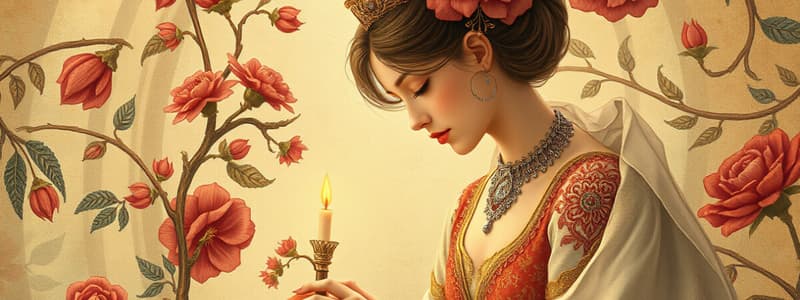Podcast
Questions and Answers
What is the main focus or theme of a work of art referred to as?
What is the main focus or theme of a work of art referred to as?
- Function
- Content
- Medium
- Subject (correct)
Which type of art is described as having a specific subject that is represented?
Which type of art is described as having a specific subject that is represented?
- Representational arts (correct)
- Abstract arts
- Conceptual arts
- Non-objective arts
What type of arts do not present identifiable objects, stories, or symbols?
What type of arts do not present identifiable objects, stories, or symbols?
- Symbolic arts
- Impressionist arts
- Representational arts
- Non-representational arts (correct)
Which of the following is NOT considered a subject in art?
Which of the following is NOT considered a subject in art?
Still lifes typically feature which kind of objects?
Still lifes typically feature which kind of objects?
Which of the following subjects would include paintings of water and beaches?
Which of the following subjects would include paintings of water and beaches?
Everyday life as a subject in art might include depictions of which of the following?
Everyday life as a subject in art might include depictions of which of the following?
Which of the following best describes the function of art?
Which of the following best describes the function of art?
What is one of the motivations behind using art for psychological and healing purposes?
What is one of the motivations behind using art for psychological and healing purposes?
Which element of art is primarily concerned with the three-dimensional aspect of an object?
Which element of art is primarily concerned with the three-dimensional aspect of an object?
How does art function as a fitness indicator according to the content?
How does art function as a fitness indicator according to the content?
What is the effect of color in art as described in the content?
What is the effect of color in art as described in the content?
In art, what does linearity describe?
In art, what does linearity describe?
What role does art play when used for propaganda?
What role does art play when used for propaganda?
What role does creativity play in the arts?
What role does creativity play in the arts?
Which of the following elements of art refers to the lightness and darkness of a color?
Which of the following elements of art refers to the lightness and darkness of a color?
What can be inferred about the use of lines in art?
What can be inferred about the use of lines in art?
How is imagination closely related to creativity?
How is imagination closely related to creativity?
In what way is expression described in the content?
In what way is expression described in the content?
Which of the following best characterizes social groups mentioned in the content?
Which of the following best characterizes social groups mentioned in the content?
What aspect of an artist's work is highlighted through imagination according to the content?
What aspect of an artist's work is highlighted through imagination according to the content?
Which of the following statements is true regarding creativity?
Which of the following statements is true regarding creativity?
How is expression depicted in relation to a person's identity?
How is expression depicted in relation to a person's identity?
Why might creativity not be exclusive to the arts?
Why might creativity not be exclusive to the arts?
What aspect does art appreciation primarily focus on?
What aspect does art appreciation primarily focus on?
Which of the following is NOT one of the assumptions of art?
Which of the following is NOT one of the assumptions of art?
In what way can art be defined as a universal language?
In what way can art be defined as a universal language?
What does art reflect about the characteristics of a period?
What does art reflect about the characteristics of a period?
Which of the following interpretations does NOT apply to art as a skill?
Which of the following interpretations does NOT apply to art as a skill?
Which statement best describes how art connects to social groups?
Which statement best describes how art connects to social groups?
How does the concept of art as a representation of reality influence its creation?
How does the concept of art as a representation of reality influence its creation?
Which of the following roles does creativity play in art?
Which of the following roles does creativity play in art?
What do vertical lines in artwork primarily convey?
What do vertical lines in artwork primarily convey?
Which of the following best describes asymmetrical balance in artwork?
Which of the following best describes asymmetrical balance in artwork?
Which element is used to create a focal point within an artwork?
Which element is used to create a focal point within an artwork?
What does the term 'contrast' refer to in visual art?
What does the term 'contrast' refer to in visual art?
In the context of performing arts, what does 'time' pertain to?
In the context of performing arts, what does 'time' pertain to?
What role does 'expression' play in performing arts?
What role does 'expression' play in performing arts?
What is the primary effect of rhythm in artwork?
What is the primary effect of rhythm in artwork?
Which element is NOT typically associated with visual weight in art?
Which element is NOT typically associated with visual weight in art?
Flashcards are hidden until you start studying
Study Notes
Digital Revolution and Art
- Marked significant changes in creating and interpreting art in the 20th century.
- Introduction of photography and video art transformed traditional art mediums.
Art Appreciation
- Definition: Understanding and enjoying man-made arts through experience with tools or possession of artworks.
- Involves learning, interpreting, and creating art.
Assumptions of Art
- Art is universal, transcending cultural and geographical boundaries.
- Distinction made between art and nature; art involves human experience and creativity.
- Art is rooted in personal and collective experiences.
Understanding Arts
- Defined through various perspectives:
- As a skill or mastery.
- As a process or an outcome of creativity.
- As a universal language communicating shared human experiences.
- Represents reality and reflects characteristics of specific historical periods.
- Serves as a window into the lives of past societies.
Creativity, Imagination, and Expression
- Creativity is essential for art; it's not just about arranging materials.
- Imagination combines ideas and feelings, originating in the artist’s mind.
- Expression is inherent in all actions, thoughts, and feelings; it's an essential part of identity.
Subject and Content of Art
- Subject: Main theme or focus of an artwork, referring to the depicted person, object, scene, or event.
- Content: Communicates ideas and interpretations, encompassing factual, conventional, and subjective meanings.
Types of Subjects in Art
- Representational Arts:
- Includes painting, sculpture, graphic arts, literature, and theater.
- Focuses on identifiable subjects.
- Non-Representational Arts:
- Lacks recognizable subjects.
- Does not convey specific stories or references.
Specific Subjects in Art
- Landscapes, seascapes, cityscapes.
- Still lifes: Inanimate objects like food, flowers, or utensils.
- Portraits and figures.
- Everyday life and historical events.
- Art as a medium for awareness of social causes.
Motivated Functions of Art
- Art addresses psychological and healing purposes through therapy.
- Acts as propaganda or commercialism, influencing viewer emotions.
- Serves as a fitness indicator, reflecting human cognitive capabilities.
Elements of Art (Visual)
- Line: Straight, curved, or a combination, influences composition.
- Form: Three-dimensional aspects created with shading, perspective, and proportion.
- Shape: Defined through lines, colors, and values.
- Value: Perception of lightness and darkness in colors.
- Texture: Surface quality, impacting visual and tactile experiences.
- Color: Evokes emotions, creates mood, and conveys meaning.
- Linearity: Direction of lines impacts composition (horizontal, vertical, diagonal).
- Balance: Distribution of visual weight, creating harmony or stability.
- Contrast: Variations in color, value, or texture to create distinct elements.
- Emphasis: Drawing attention to specific areas using contrast and placement.
- Rhythm: Repetition of elements that create movement and flow within art.
Elements of Performing Arts
- Performer: Individuals or groups bringing the piece to life.
- Audience: Observers intentionally engaged with the performance.
- Space: The physical location, like a stage or theater.
- Time: Pacing and rhythm enhance narrative flow.
- Expression: Communication of emotions through facial expressions, gestures, and body language.
- Storytelling or Plot: Narrative elements driving the performance.
- Sound: Enhances the overall experience and enriches the storytelling.
Studying That Suits You
Use AI to generate personalized quizzes and flashcards to suit your learning preferences.




